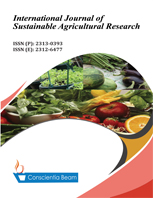Combined Microbial Inoculation as a Promising Approach to Enhance Promiscuous Soybean Nodulation and Nitrogen Content in Sudan Savanna
DOI:
https://doi.org/10.18488/journal.70/2015.2.3/70.3.86.97Abstract
Applications of microbial inoculants and reduced amount of inorganic fertilizers could lead to low-input agriculture and sustain smallholders’ crops production. In this study, the effect of promiscuous soybean inoculation with combined microbial inoculants was evaluated during harmattan season under furrow irrigation. Rhizobial inoculants and urea on one hand, and fungal inoculants and triple superphosphate (TSP) on the other hand, were considered as nitrogen (N) and phosphorus (P) sources, respectively. The soil was sandy loam and slightly alkaline. Significant effect from rhizobial inoculants was observed on nodule dry weight. As well, the interaction between N and P source had significant effect on %Ndfa. The interaction between 1495MAR and TSP induced the highest %Ndfa. The dual inoculation of 1495MAR and Rhizatech induced relatively high shoot N content. This study showed TGx soybean responded to rhizobial inoculation in Nigeria Sudan savanna. It showed that biofertilizers could effectively increase soybean yield under furrow irrigation. It also suggested that microbial inoculants could perform during harmattan season. Furthermore, the study showed that selective interactions occur between rhizobial strains and fungal inoculants for soybean development.

